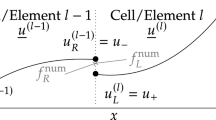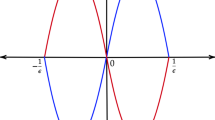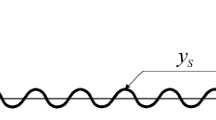Abstract
We solve two problems ofx∈[−∞, ∞] for arbitrary orderj. The first is to compute shock-like solutions to the hyperdiffusion equation,u1=(−1)j+1 u 2j,x. The second is to compute similar solutions to the stationary form of the hyper-Burgers equation, (−1)j u 2j.x+uu x=0; these tanh-like solutions are asymptotic approximations to the shocks of the corresponding time dependent equation. We solve the hyperdiffusion equation with a Fourier integral and the method of steepest descents. The hyper Burgers equation is solved by a Fourier pseudospectral method with a polynomial subtraction.
Except for the special case of ordinary diffusion (j=1), the jump across the shock zone is described bynonmonotonic, oscillatory functions. By smearing the front over the width of a grid spacing, it is possible to numerically resolve the shock with a weaker and weaker viscosity coefficient asj, the order of the damping, increases. This makes such “hyperviscous” dampings very attractive for coping with fronts since, outside the frontal zone, the impact of the artificial hyperviscosity is much smaller than with ordinary viscosity. Unfortunately, both the intensity of the oscillations and the slowness of their exponential decay from the center of the shock zone decrease asj increases so that the shock zone is muchwider than for ordinary diffusion. We also examined generalizations of Burgers equation with “spectral viscosity”, that is, damping which is tailored to yield exponentially small errors outside the frontal zone when combined with spectral methods. We find behavior similar to high order hyperviscosity.
We conclude that high order damping, as a tool for shock-capturing, offers both advantages and drawbacks. Monotonicity, which has been the holy grail of so much recent algorithm development, is a reasonable goal only for ordinary viscosity. Hyperviscous fronts and shock zones in flows with “spectral viscosity” aresupposed to oscillate.
Similar content being viewed by others
References
Abramowitz, M., and Stegun, I. (1965).Handbook of Mathematical Functions. Dover, New York, p. 1000.
Bateman, H. (1951). Some recent researches on the motion of fluids.Mon. Wea. Rev. 43, 163–170.
Bender, C. M., and Orszag, S. A. (1978).Advanced Mathematical Methods for Scientists and Engineers. McGraw-Hill, New York, p. 266.
Benton, E. R., and Platzman, G. W. (1972). A table of solutions of the one-dimensional Burgers equation.Quart. Appl. Math. 30, 195–212.
Blumen, W. (1980). A comparison between the Hoskins-Bretherton model of frontogenesis and the analysis of an intense surface frontal zone.J. Atmos. Sci. 37, 64–77.
Blumen, W. (1981). The geostrophic coordinate transformation.J. Atmos. Sci. 38, 1100–1105.
Blumen, W. (1987). Energy spectra associated with Long's model for steady finite amplitude flow over orography.Geophys. Astrophys. Fluid Dyn. 38, 265–272.
Blumen, W. (1990a). Finite-amplitude mountain waves in a compressible atmosphere including the effects of dissipation.Geophys. Astrophys. Fluid Dynamics 52, 89–104.
Blumen, W. (1990b). A Semi-geostrophic Eady-wave frontal model incorporating momentum diffusion. Part I. Model and solutions.J. Atmos. Sci. 47, 2890–2902.
Blumen, W. (1990c). A Semi-geostrophic Eady-wave frontal model incorporating momentum diffusion. Part II. Kinetic energy and enstrophy dissipation.J. Atmos. Sci. 47, 2903–2908.
Boyd, J. P. (1980). The nonlinear equatorial Kelvin wave.J. Phys. Oceangr. 10, 1699–1718.
Boyd, J. P. (1982). The optimization of convergence for Chebyshev polynomial methods in an unbounded domain.J. Comp. Phys. 45, 43–79.
Boyd, J. P. (1988). Chebyshev domain truncation is inferior to Fourier domain truncation for solving problems on an infinite interval.J. Scient. Comp. 3, 109–120.
Boyd, J. P. (1989).Chebyshev and Fourier Spectral Methods. Lecture Notes in Engineering, Springer-Verlag, New York,49, 800.
Boyd, J. P. (1992). The energy spectrum of fronts: The time evolution of shocks in Burgers' equation.J. Atmos. Sci. 49, 128–139.
Cai, W., and Gottlieb, D., and Shu, C.-W. 1989: Essentially nonoscillatory spectral Fourier methods for shock wave calculations.Math. Comp. 52, 389–410.
Charney, J. C. (1971). Geostrophic turbulence.J. Atmos. Sci. 28, 1087–1095.
Gottlieb, D., and Tadmor, E. (1985). Recovering pointwise values of discontinuous data with spectral accuracy, in:Progress and Supercomputing in Computational Fluid Dynamics, E. M. Murman and S. S. Abarbanel, (eds.), Birkhauser, Basel, pp. 357–375.
Hedstrom, G. (1975). Models of difference schemes foru t+ux=0 by partial differential equations.Math. Comp. 29, 969–977.
Hooper, A. P., and Grimshaw, R. (1988). Travelling wave solutions of the Kuramoto-Sivashinsky equation.Wave Motion 10, 405–420.
Hoskins, B. J., and Bretherton, F. P. (1972). Atmospheric frontogenesis models: Mathematical formulation and solution.J. Atmos. Sci. 29, 11–37.
Hoskins, B. J. (1982). The mathematical theory of frontogenesis.Ann. Rev. Fluid Mech. 14, 131–151.
Kevorkian, J., and Cole, J. D. (1981).Perturbation Methods in Applied Mathematics. Springer-Verlag, New York, p. 558.
Korner, T. W. (1988).Fourier Analysis. Cambridge University Press, New York, p. 590.
Lesser, M. B., and Chrighton, D. G. (1975). Physical acoustics and the method of matched asymptotic expansions. W. P. Mason and R. N. Thurston, (eds.), Academic Press, New York,Physical Acoustics 11, 69–149.
LeVeque, R. J. (1990).Numerical Methods for Conservation Laws. Birkhauser, Basel, pp. 117–121.
Lighthill, M. J. (1958).Introduction to Fourier Analysis and Generalized Functions. Cambridge University Press, Cambridge, p. 79.
Lyness, J. N. (1971). Adjusted forms of the Fourier Coefficient Asymptotic Expansion and applications in numerical quadrature.Math. Comp. 25, 87–104.
Lyness, J. N. (1984). The calculation of trigonometric Fourier coefficients.J. Comp. Phys. 54, 57–73.
Maday, Y., and Tadmor, E. (1989). Analysis of the spectral viscosity method for periodic conservation laws.SIAM J. Numer. Anal. 26, 854–870.
Platzman, G. W. (1964). An exact integral of complete spectral equations for unsteady onedimensional flow.Tellus 16, 422–431.
Roe, P. L. (1986). Characteristic-based schemes for the Euler equations.Ann. Rev. Fluid Mech. 18, 337–365.
Schochet, E. (1991). The rate of convergence of spectral-viscosity methods for periodic conservation laws.SIAM J. Numer. Anal., (to appear).
Tadmor, E. (1989). Convergence of spectral methods for nonlinear conservation laws.SIAM J. Numer. Anal. 26, 30–44.
Tadmor, E. (1990). Shock capturing by the spectral viscosity method.Comput. Meth. Appl. Mech. Engin. 80, 197–208.
Van Dyke, M. (1964).Perturbation Methods in Fluid Mechanics. Academic Press, New York, pp. 106–109.
Warming, R., and Hyett, ?. (1974). The modified equation approach to the stability and accuracy analysis of finite difference methods.J. Comp. Phys. 14, 159–179.
Whitham, G. B. (1974).Linear and Nonlinear Waves. John Wiley, p. 99.
Author information
Authors and Affiliations
Rights and permissions
About this article
Cite this article
Boyd, J.P. Hyperviscous shock layers and diffusion zones: Monotonicity, spectral viscosity, and pseudospectral methods for very high order differential equations. J Sci Comput 9, 81–106 (1994). https://doi.org/10.1007/BF01573179
Received:
Issue Date:
DOI: https://doi.org/10.1007/BF01573179




